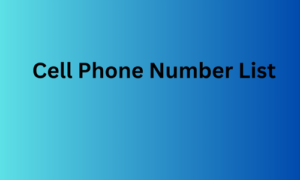How to generate demand on the Internet?
Posted: Sun Dec 15, 2024 8:13 am
How to get customers to line up to buy your product?
What is demand generation?
Demand generation is a holistic approach to marketing. Some might even say that it is the foundation of all marketing.
It is important to understand how demand works and what is the psychology of the customers who are looking for your brand? Who are they? What do they need? What stages does the buyer's journey consist of?
Understanding demand will help you:
To develop a coherent marketing strategy that takes into account both existing interests and new emerging opportunities;
Choose the right marketing channels and platforms to communicate with your target audience;
Determine which marketing activities will be most cell phone number list effective and cost-effective in your case.
What is the difference between demand generation and lead generation?
Lead generation is about reaching people who are almost thinking about making a purchase. Demand generation is about reaching people who don’t even know they need your products or services yet.
Over the last decade or so, most marketers have focused on lead generation. This is partly because customer relationship management (CRM) software has dominated marketing . Lead generation is especially popular among small businesses that don’t have huge budgets and want the most digitized, fast, and predictable results. Marketers today focus on lead acquisition, nurturing, and attribution. But this is not the full marketing cycle.

Tracking and generating quality leads requires a lot of computing power and time to build a marketing funnel, while it is not always possible to achieve a high return on investment in marketing. Attribution is not a 100% correct source of data, hence the excess costs of attracting non-targeted leads and errors in strategic planning.
The demand generation strategy is opposed to classic lead generation. When generating demand, we do not try to fish out a few goldfish in the form of warm leads from the vast sea of the market, but create a fish farm, increasing the number of people willing to buy our product or service in principle.
The answer to the question: What does a person need to know to become interested in your brand and, ultimately, become a client? is the key to understanding how to generate demand. Let's look into this in more detail.
What is demand generation?
Demand generation is a holistic approach to marketing. Some might even say that it is the foundation of all marketing.
It is important to understand how demand works and what is the psychology of the customers who are looking for your brand? Who are they? What do they need? What stages does the buyer's journey consist of?
Understanding demand will help you:
To develop a coherent marketing strategy that takes into account both existing interests and new emerging opportunities;
Choose the right marketing channels and platforms to communicate with your target audience;
Determine which marketing activities will be most cell phone number list effective and cost-effective in your case.
What is the difference between demand generation and lead generation?
Lead generation is about reaching people who are almost thinking about making a purchase. Demand generation is about reaching people who don’t even know they need your products or services yet.
Over the last decade or so, most marketers have focused on lead generation. This is partly because customer relationship management (CRM) software has dominated marketing . Lead generation is especially popular among small businesses that don’t have huge budgets and want the most digitized, fast, and predictable results. Marketers today focus on lead acquisition, nurturing, and attribution. But this is not the full marketing cycle.

Tracking and generating quality leads requires a lot of computing power and time to build a marketing funnel, while it is not always possible to achieve a high return on investment in marketing. Attribution is not a 100% correct source of data, hence the excess costs of attracting non-targeted leads and errors in strategic planning.
The demand generation strategy is opposed to classic lead generation. When generating demand, we do not try to fish out a few goldfish in the form of warm leads from the vast sea of the market, but create a fish farm, increasing the number of people willing to buy our product or service in principle.
The answer to the question: What does a person need to know to become interested in your brand and, ultimately, become a client? is the key to understanding how to generate demand. Let's look into this in more detail.